Link About It: This Week’s Picks
A new NYC park, electric animals, a zine for sober and sober-curious people and more from around the web

NYC’s Little Island Opens
 Little Island, a 2.4-acre park covered in plants and pathways on concrete piles sprouting up from the Hudson River, has opened to the public. Two boardwalks connect the whimsical destination with the Hudson River Greenway at 13th and 14th Streets. Barry Diller (the chairman of IAC/InterActiveCorp) took on the project in 2013 with his wife, fashion designer Diane von Furstenberg. They commissioned architect Thomas Heatherwick to imagine the structure, which he then proposed would be 132 unique concrete “tulips” topped with trees, flowers and places to play. It took five years to build and now welcomes visitors, who are encouraged to wander—and even walk upon Little Island’s various lawns. Read more at Bloomberg, or visit any day from 6AM to 1AM.
Little Island, a 2.4-acre park covered in plants and pathways on concrete piles sprouting up from the Hudson River, has opened to the public. Two boardwalks connect the whimsical destination with the Hudson River Greenway at 13th and 14th Streets. Barry Diller (the chairman of IAC/InterActiveCorp) took on the project in 2013 with his wife, fashion designer Diane von Furstenberg. They commissioned architect Thomas Heatherwick to imagine the structure, which he then proposed would be 132 unique concrete “tulips” topped with trees, flowers and places to play. It took five years to build and now welcomes visitors, who are encouraged to wander—and even walk upon Little Island’s various lawns. Read more at Bloomberg, or visit any day from 6AM to 1AM.
Image courtesy of Kenny Castor
Step Into Art Duo Semiconductor’s “Recreation” of the Big Bang
![]() At this year’s Brighton Festival, art duo Semiconductor (aka Ruth Jarman and Joe Gerhardt) presents “Halo,” a multi-sensory work that immerses visitors in a recreation of the Big Bang. Jarman and Gerhardt transformed data from subatomic particle collisions at Switzerland’s Cern (where they work as artists) into a 360-degree enclosure of 384 vertical wires aswirl with pulsing lights, coupled with industrial sound effects. It’s a poetic dramatization of an event few can comprehend that might bring attendees a bit closer to understanding the universe. Read more at The Guardian.
At this year’s Brighton Festival, art duo Semiconductor (aka Ruth Jarman and Joe Gerhardt) presents “Halo,” a multi-sensory work that immerses visitors in a recreation of the Big Bang. Jarman and Gerhardt transformed data from subatomic particle collisions at Switzerland’s Cern (where they work as artists) into a 360-degree enclosure of 384 vertical wires aswirl with pulsing lights, coupled with industrial sound effects. It’s a poetic dramatization of an event few can comprehend that might bring attendees a bit closer to understanding the universe. Read more at The Guardian.
Image courtesy of Semiconductor, ©Claudia Marcelloni CERN
Explore the Venice Architecture Biennale 2021 Online
 In advance of the Venice Architecture Biennale 2021 (which opens to the public on 22 May) six nations—Estonia, Switzerland, Lithuania, Great Britain, Finland and Luxembourg—worked together to develop Biennale Pavilions, an independent digital platform that grants visitors access to their physical entries, events and broadcasts. Currently the growing list includes 19 countries that plan to utilize the platform, which will incorporate an archive for people to revisit everything long after the event concludes. In-person visitors can also utilize the online platform to supplement their experience. Read more about the technology and this year’s theme, “How will we live together?,” at Architizer.
In advance of the Venice Architecture Biennale 2021 (which opens to the public on 22 May) six nations—Estonia, Switzerland, Lithuania, Great Britain, Finland and Luxembourg—worked together to develop Biennale Pavilions, an independent digital platform that grants visitors access to their physical entries, events and broadcasts. Currently the growing list includes 19 countries that plan to utilize the platform, which will incorporate an archive for people to revisit everything long after the event concludes. In-person visitors can also utilize the online platform to supplement their experience. Read more about the technology and this year’s theme, “How will we live together?,” at Architizer.
Image courtesy of the Estonian Pavillion
The Creative Independent’s Free “Sober 21” Zine + Sobriety Resource
 Free to download, the Sober 21 zine from The Creative Independent (Kickstarter’s editorial arm) compiles candid conversations with music industry professionals—from Nile Rodgers to Darryl “DMC” McDaniels, Mix Master Mike, Interpol’s Brad Truax, Moby and more—on battling addiction and staying clean. Presenter and frontman Elia Einhorn assembled and edited the compilation as a free resource with practical tips for sober and sober-curious musicians. Download the PDF at The Creative Independent. It will also be published in a physical format soon.
Free to download, the Sober 21 zine from The Creative Independent (Kickstarter’s editorial arm) compiles candid conversations with music industry professionals—from Nile Rodgers to Darryl “DMC” McDaniels, Mix Master Mike, Interpol’s Brad Truax, Moby and more—on battling addiction and staying clean. Presenter and frontman Elia Einhorn assembled and edited the compilation as a free resource with practical tips for sober and sober-curious musicians. Download the PDF at The Creative Independent. It will also be published in a physical format soon.
Image courtesy of The Creative Independent
Roll & Hill’s First-Ever Furniture Collection
 In 2020, Brooklyn-based lighting design firm Roll & Hill acquired the 75-year-old, Grand Rapids, Michigan-based furniture brand Alexis Manufacturing Company. As a result, Roll & Hill now introduces their first-ever furniture collection, a premium all-wood series of stools, chairs and tables. The eight debut pieces were either designed by Jason Miller (Roll & Hill’s founder), Karl Zahn or Campagna (who imagined an angular, three plane chair and a circular “Sit, Set Chair”)—and materials range from walnut to oak and maple. Read more at Design Milk, where you can see photos of the entire collection.
In 2020, Brooklyn-based lighting design firm Roll & Hill acquired the 75-year-old, Grand Rapids, Michigan-based furniture brand Alexis Manufacturing Company. As a result, Roll & Hill now introduces their first-ever furniture collection, a premium all-wood series of stools, chairs and tables. The eight debut pieces were either designed by Jason Miller (Roll & Hill’s founder), Karl Zahn or Campagna (who imagined an angular, three plane chair and a circular “Sit, Set Chair”)—and materials range from walnut to oak and maple. Read more at Design Milk, where you can see photos of the entire collection.
Image courtesy of Roll & Hill
Animals That Rely on Electricity
 Roughly 350 species of fish can generate electricity—some up to 860 volts of power (far more than an electric shock from a household outlet, which measures around 120). Of course, there’s the well-known electric eel (which is actually an eel-shaped fish), but sharks and rays use electricity, too. On land, the platypus, echidna and even the bumblebee works with electricity. All of these creatures are categorized as either elecrogenic or electroreceptive, either producing or registering currents (though, some are both) and in many cases the relationship to electricity is as important as any other sense. To learn more about the way various species—dolphins included—rely upon electricity, head over to National Geographic.
Roughly 350 species of fish can generate electricity—some up to 860 volts of power (far more than an electric shock from a household outlet, which measures around 120). Of course, there’s the well-known electric eel (which is actually an eel-shaped fish), but sharks and rays use electricity, too. On land, the platypus, echidna and even the bumblebee works with electricity. All of these creatures are categorized as either elecrogenic or electroreceptive, either producing or registering currents (though, some are both) and in many cases the relationship to electricity is as important as any other sense. To learn more about the way various species—dolphins included—rely upon electricity, head over to National Geographic.
Image courtesy of George Grall / Nat Geo Image Collection
Link About It is our filtered look at the web, shared daily in Link and on social media, and rounded up every Saturday morning. Hero image courtesy of the Estonian Pavilion at Venice Architecture Biennale










